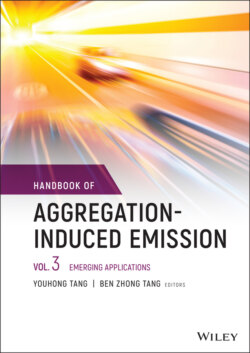Читать книгу Handbook of Aggregation-Induced Emission, Volume 3 - Группа авторов - Страница 31
2.4 Metal Complexes and Clusters
ОглавлениеLuminescent metal complexes also face the ACQ problem. Endowing metal complexes with AIE feature would greatly expand their applications in imaging and luminescent sensor. In 2018, Xiang’s group prepared a new class of chiral Pt(II)‐Salen complexes 36–40 (Figure 2.9) [29]. For all the complexes, nearly no emission was detected in dilute solutions of organic solvents such as CH2Cl2, benzene, MeCN, and THF, whereas they generated near‐infrared emission in THF/H2O mixtures or in the solid state. With the absence of a traditional AIE‐active moiety, complexes 36–40 showed strong AIE activity. Theoretical calculations revealed that the binaphthyl unit quickly rotated in the solution and consequently caused luminescence quenching. In the aggregated state, the restriction of intramolecular motions (RIM) led to the near‐infrared emission. Complex 37 showed AICPL when excited at 460 nm with glum of ±5.0 × 10−3 (650 nm). Enantiopure 39 also exhibited CPL at 655 nm with lower glum of ±3.0 × 10−3. The same group also prepared a series of chiral binuclear Pt(II) complexes in 2019 [30]. With binaphthyl quinoline as the bridge ligand, these complexes possessed helical structure, and exhibited CPL with high glum up to ±1.0 × 10−2 (653–683 nm).
Figure 2.9 Molecular structures of chiral Pt(II)‐Salen complexes 36–40 and corresponding glum [29].
Recently, several AICPL systems based on chiral clusters were also investigated. In 2017, Tang and coworkers synthesized a chiral Au3 cluster with unique optical absorption activity (Figure 2.10) [31]. For an individual cluster 41, nearly no luminescence was observed. Interestingly, due to the strong CH/ π interaction, 41 self‐organized into nanocubes with a body‐centered cubic packing in a CH2Cl2/hexane mixture and exhibited intense CPL signal with glum of ±7.0 × 10−3 (583 nm).
Figure 2.10 Molecular structures of chiral Au3 cluster enantiomers R‐41 and S‐41 and corresponding glum [31].
In 2019, Zang and coworkers prepared an atomically precise chiral copper(I) cluster 42 ([Cu14(R/S‐DPM)8](PF6)6) with a typical AIE feature and CPL activity from chiral ligands R‐DPM and S‐DPM (Figure 2.11) [32]. The PL intensity of 42 increased when the fraction of n‐hexane increased in the CH2Cl2/hexane mixtures. In a dimethyl sulfoxide (DMSO)/H2O system, similar AIE effect was also observed. As for chiroptical properties, obvious CPL signals were observed with glum up to ±1.0 × 10−2 (702 nm) for R‐42 and S‐42 when the fraction of n‐hexane exceeded 40%.
Figure 2.11 (a) Molecular structures of chiral ligands R‐DPM and S‐DPM. (b) Single crystal structures of R‐42 and S‐42, and corresponding glum in CH2Cl2/hexane mixtures.
Source: Reproduced with permission [32]. Copyright 2019, Wiley‐VCH.
In 2020, a propeller‐like chiral trinuclear copper(I) cluster 43 was reported by Zang’s group (Figure 2.12) [33]. By introducing several flexible phenyl groups into the cluster, 43 was endowed with AIE activity following the RIM mechanism. CD spectra indicated that the chirality belonged to cluster 43 rather than the isolated chiral ligands. In the aggregated state (in DMSO/H2O mixtures), remarkable CPL signal was observed with glum of ±2.0 × 10−2 (610 nm).
Figure 2.12 Molecular structures of chiral copper cluster enantiomers R‐43 and S‐43 and corresponding glum [33].
